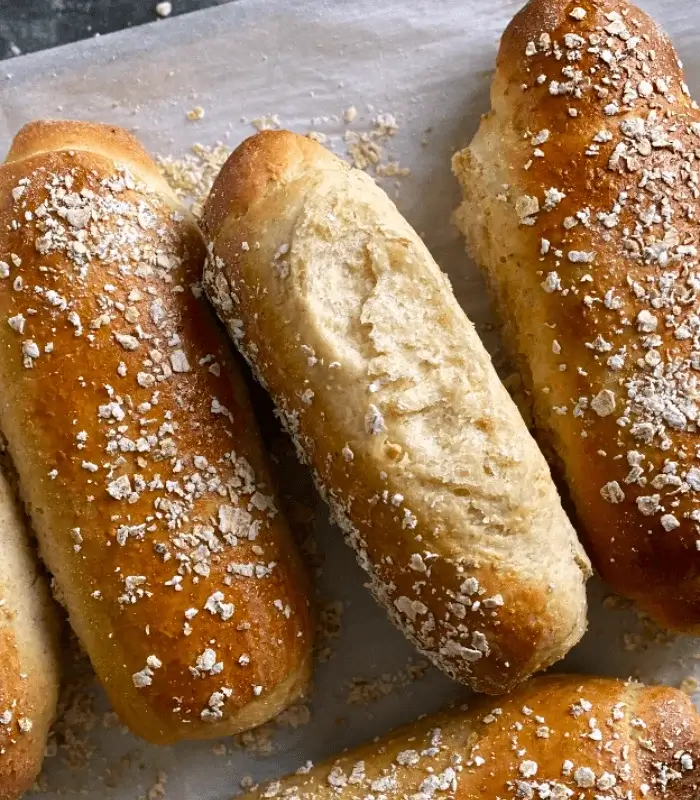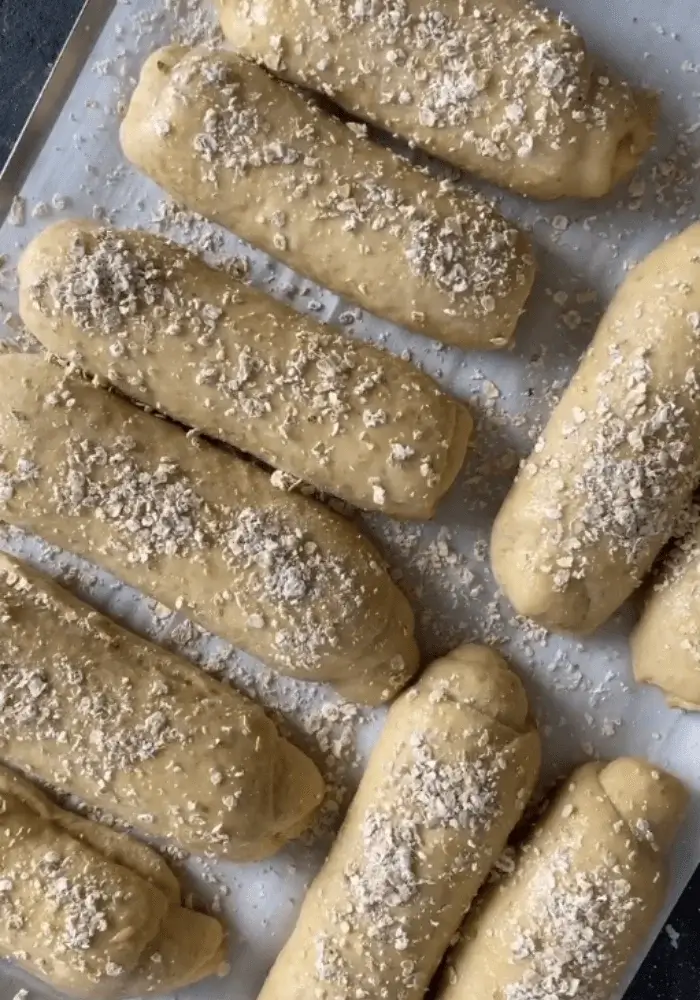The Fluffiest Gluten Free Rolls
We may earn a commission from recommended products, at no extra cost to you. See Disclosure.
INGREDIENTS
Dough:
- 3 cups/380 grams gluten-free flour
- 0.5 ounce/15 grams fresh yeast
- 1 cup/100 grams rolled oats
- 3.5 tablespoons/70 grams honey
- 2 eggs
- 2 tablespoons/30 grams butter, softened
- 1 cup/240 milliliters water
- Pinch of salt
Topping:
- 1 egg, beaten (for brushing)
- Rolled oats, for garnish
INSTRUCTIONS
- Preheat the oven to 355°F (180°C), using a convection setting if available.
- In the bowl of a stand mixer, combine the flour, yeast, oats, honey, eggs, and water. Attach the dough hook and mix on medium speed. Once the ingredients begin to come together, add the butter and salt. Continue kneading for about 15 minutes, until the dough is smooth and elastic.
- Transfer the dough to a lightly greased bowl, cover, and let rise until doubled in size.
- Once risen, turn the dough out onto a floured surface and divide it into 14 equal portions. Roll each portion into a rectangle, then tightly roll into a log shape to form long, slender rolls.
- Arrange the rolls on a parchment-lined baking sheet, spacing them evenly. Let them rise at room temperature until doubled in size, about 30-50 minutes.
- Brush the tops with the beaten egg and sprinkle with rolled oats. Bake for 15-20 minutes, or until golden brown.
- Remove from the oven and let cool before serving. These rolls are perfect for sandwiches or simply enjoyed with butter.
- Store in an airtight bag at room temperature for up to 5 days, or freeze for up to a month.

FAQ
What makes these gluten free rolls soft and fluffy?
Gluten free rolls require a careful balance of ingredients to achieve a soft and fluffy texture. Because gluten is responsible for elasticity in traditional dough, using a blend of gluten-free flours is essential. Starches like tapioca or potato starch help lighten the texture, while xanthan gum or psyllium husk can mimic gluten’s structure. Proper hydration is also crucial, as gluten-free flours absorb more liquid than wheat flour. A long kneading time ensures all ingredients are well combined, and allowing the dough to rise fully before baking gives the rolls a better structure. Baking at the right temperature with enough steam in the oven can further enhance softness.
Can I substitute the honey with another sweetener?
Yes, honey can be substituted with other liquid sweeteners like maple syrup, agave nectar, or even a simple syrup made from sugar and water. If using granulated sugar, you may need to add a little extra liquid to maintain the dough’s hydration. Honey adds both moisture and a mild sweetness to gluten free rolls, so replacing it with a different sweetener may slightly affect the final texture and taste. Keep in mind that some sweeteners, like coconut sugar or molasses, can change the color and flavor of the rolls. If using a sugar substitute like erythritol, check if it affects yeast activity, as some sugar-free alternatives do not feed yeast properly.
Can I substitute the honey with another sweetener?
Yes, honey can be substituted with other liquid sweeteners like maple syrup, agave nectar, or even a simple syrup made from sugar and water. If using granulated sugar, you may need to add a little extra liquid to maintain the dough’s hydration. Honey adds both moisture and a mild sweetness to gluten free rolls, so replacing it with a different sweetener may slightly affect the final texture and taste. Keep in mind that some sweeteners, like coconut sugar or molasses, can change the color and flavor of the rolls. If using a sugar substitute like erythritol, check if it affects yeast activity, as some sugar-free alternatives do not feed yeast properly.

What type of gluten-free flour works best for this recipe?
A good blend of gluten-free flour is key to making successful gluten free rolls. Store-bought all-purpose gluten-free flour blends that contain rice flour, tapioca starch, and xanthan gum are convenient and effective. If making your own blend, a mix of white rice flour, brown rice flour, potato starch, and a small amount of almond flour can provide both structure and softness. Avoid using only a single flour, like almond or coconut flour, as they lack the necessary binding properties. If your blend does not include xanthan gum or psyllium husk, you will need to add it separately to improve dough elasticity.
How do I store gluten free rolls to keep them fresh?
To keep gluten free rolls fresh, store them in an airtight container at room temperature for up to 3 days. If you need longer storage, refrigerate them for up to a week, though this may cause them to dry out slightly. For the best long-term storage, freeze the rolls in a sealed bag or airtight container for up to a month. When ready to eat, thaw them at room temperature or warm them in the oven at 300°F (150°C) for a few minutes to restore softness. Avoid storing gluten free rolls in the fridge without wrapping them properly, as they can become stale more quickly.
Can I make these rolls dairy-free as well?
Yes, these gluten free rolls can be made dairy-free by replacing butter with a plant-based alternative, such as vegan butter or coconut oil. Use unsweetened almond milk, oat milk, or another dairy-free option instead of regular milk if the recipe calls for it. Some dairy-free substitutes, like coconut oil, may slightly alter the texture, making the rolls denser. Choosing a dairy-free fat that remains soft at room temperature, like vegan butter, can help maintain a more traditional texture. If using margarine, check that it is free from hydrogenated oils for the best results.

Why didn’t my gluten free rolls rise properly?
Several factors can prevent gluten free rolls from rising correctly. First, ensure that the yeast is fresh and activated in warm liquid (around 100°F/38°C) before mixing it into the dough. Too much flour or too little liquid can make the dough too dense to expand properly. Gluten-free doughs need longer rising times, sometimes up to twice as long as wheat-based doughs, so be patient. The environment should be warm (75–85°F or 24–29°C) but not too hot, as excessive heat can kill the yeast. Lastly, check that you are using a flour blend with enough starch and binding agents like xanthan gum or psyllium husk to support the dough’s structure.
Can I freeze the dough instead of the baked rolls?
Yes, you can freeze the dough instead of the baked gluten free rolls. After the first rise, shape the dough into rolls and place them on a baking sheet lined with parchment paper. Freeze until solid, then transfer to an airtight container or freezer bag. When ready to bake, allow the rolls to thaw and complete their second rise at room temperature for 1 to 2 hours before baking as usual. Freezing the dough may slightly alter the final texture, but it is a convenient way to prepare rolls in advance.
Can I add seeds or other toppings for extra texture?
Yes, adding seeds or other toppings can enhance the texture and flavor of gluten free rolls. Before baking, brush the rolls with an egg wash or melted butter to help toppings adhere. Popular choices include sesame seeds, sunflower seeds, poppy seeds, or even oats for a rustic look. You can also sprinkle coarse sea salt, garlic powder, or dried herbs for added flavor. If using larger toppings like pumpkin seeds, lightly press them into the dough to prevent them from falling off during baking. Be mindful that some seeds can burn quickly, so monitor the rolls closely while baking.
What’s the best way to reheat gluten free rolls?
The best way to reheat gluten free rolls is in the oven at 300°F (150°C) for about 5–10 minutes. This helps restore their softness and prevents them from becoming dry. If reheating from frozen, allow the rolls to thaw at room temperature before warming them in the oven. For a quicker method, microwave the rolls for 10–15 seconds, covering them with a damp paper towel to retain moisture. Avoid overheating in the microwave, as this can make them tough or rubbery. Adding a small dish of water to the oven while reheating can also help maintain moisture.

